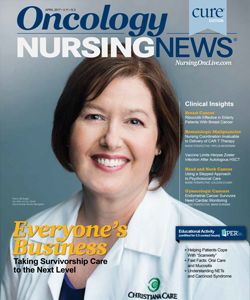"Scanxiety": Helping Patients Cope
Patients with cancer know all too well the worry that accompanies waiting for test results. What can healthcare providers do to help?
Lisa Schulmeister, MN, RN, ACNS-BC, FAAN

Lisa Schulmeister, MN, RN, ACNS-BC, FAAN
“Scanxiety” refers to the fear and worry associated with imaging, both before and after a test is performed, and lasts until the test results are communicated to the patient. As described by cancer survivor Bruce Feiler in a Time magazine column, “Scans are like revolving doors, emotional roulette wheels that spin us around for a few days and spit us out the other side. Land on red, we’re in for another trip to Cancerland; land on black, we have a few more months of freedom.”
Although the word “scanxiety” has primarily been used in the context of cancer diagnosis and treatment and imaging testing, similar anxiety can be elicited when a variety of tests are performed for other diseases. The root of this anxiety is thought to be related to the uncertainty of the test results and the amount of time that elapses between when the test is performed and the results known. Not surprisingly, most patients report an escalation of anxiety that correlates with longer wait times.
In an ideal world, scanxiety could be alleviated by immediate test results. However, test results also need someone qualified to interpret them and explain their implications. When scans show no evidence of disease, or a blood test is within normal limits, the phone calls are easy to make. It’s a different story when the scans or tests are abnormal or indicate disease progression. In these cases, face-to-face conversations about treatment options are usually best.
"PHONE TAG" FRUSTRATION
Resources for Your Patients
- 10 Tips for Coping with Scanxiety: written by a 2-time cancer survivor.
- Strategies for Reducing Scanxiety: a 12-minute video presented by Memorial Sloan Kettering Cancer Center’s Laura Liberman, MD, FACR, a physician, breast-imaging expert, and lymphoma survivor.
So, what can healthcare providers do to reduce scanxiety? Some oncology practices schedule patients for a clinic visit on the same day a scan or test is performed. Of course, this approach only works when there is collaboration between the imaging or laboratory department and oncology providers. “The test results are not back yet” are words no patient wants to hear on a follow-up visit.
Patients who have scans and tests performed in their hometowns need to be informed that test results may or may not be available on the same day. These patients should be instructed to call their oncology providers to obtain results rather than wait for a call with the results.
Every oncology facility should have procedures that reduce the likelihood that patients will “fall through the cracks” and not be followed up. This can happen when return calls to patients go unanswered. The resulting “phone tag” is frustrating for patients and healthcare providers alike.
After-hours calls are particularly challenging, as they are often placed or received via personal cellphones. One option is to block or hide personal cellphone numbers; however, patients may ignore or decline these calls since the callers are not identified. Another option is the Doximity Dialer, an app that allows healthcare providers to call patients without revealing their personal cellphone numbers. Patients see an office or clinic number instead. The app allows healthcare providers to call patients at any US number, choose the caller ID that appears, and send return calls to an office or clinic.
The app can be downloaded for iPhone at the App Store and for Android devices at Google Play.
HOW CAN I HELP?
What else can be done to reduce scanxiety? Cognitive-behavioral therapy (CBT) may be helpful in dealing with the thoughts that are at the root of the anxiety. CBT helps by examining possible outcomes. This leads to a reduction in all or nothing, catastrophic thinking, which in turn reduces anxiety.
The bottom line is that there are a number of strategies to help patients reduce scanxiety and cope with its effects (Box). Being diagnosed with cancer is hard enough; we need to do all we can do to make the journey less stressful.
Do you have tips for helping to reduce your patients’ anxiety? Send an email to Lauren Green at lgreen2@onclive.com lgreen2@onclive.com, and we’ll share them on our website here.

Innovative Program Reduces Nurse Turnover and Fosters Development
Published: September 12th 2024 | Updated: September 12th 2024The US Oncology Network (The Network) has developed one of the most comprehensive programs in the nation to support the professional development and retention of new oncology nurses.


